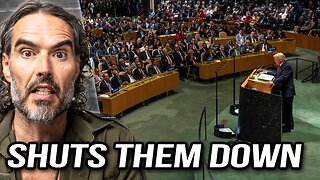Premium Only Content

Netanyahu Wanted to Look Tough – Now He Just Looks Desperate
Right, so Father Gabriel Romanelli had become, almost inadvertently, a symbol of human resilience amid the devastation of Gaza. For months, he answered the phone each night to hear Pope Francis’ reassuring words, his parish functioning as one of the last sanctuaries in a city reduced to rubble. Romanelli is of course the pastor of The Holy Family Catholic Church, Gaza’s only Catholic place of worship. he had been sheltering hundreds of displaced civilians—many elderly, disabled, or children – the Christian thing to do. And yet, yesterday, Israeli tank shells tore through that sanctuary, killing at least three civilians, including two women, and wounding at least ten others, among them Romanelli himself, whose leg was hastily bandaged before he was rushed to Al-Ahli Hospital. Images of shattered pews, broken stained glass, and Father Romanelli lying in shock among the rubble rapidly spread across the world, provoking anger far beyond the usual pro-Palestinian circles.
The incident was more than just another tragedy in Gaza’s long list of tragedies though. It was a symbolic moment that reinforce a growing perception: that Israel’s campaign in Gaza was no longer just a war against Hamas; or against the civilian populace of Gaza either, but that it has become a war against faith itself and when we look at the broader context of that statement beyond Gaza to the West Bank too and beyond Christianity as well, its becoming very hard to see things otherwise, yet more hypocrisy from the self-declared Jewish state that weaponises antisemitism to silence its critics, yet seemingly cannot extend that same demand for religious respect to other faiths. When a priest personally known to the former Pope is maimed in a bombardment, Israel’s carefully crafted narrative of “precision targeting” becomes an even bigger joke doesn’t it? This was not an isolated accident but part of a broader pattern of disregard for non-Jewish life and heritage, a pattern evident in the destruction of over a thousand mosques, repeated strikes on churches, and the abuse of Islamic holy sites in the West Bank.
Israel would never tolerate synagogues getting targeted in retaliatory strikes on it, so why should they hide behind claims of religious persecution, Zionist falsehoods as they are, when they appear to be very much engaged in that themselves?
Right, so first off caveat, a point I want to make from the get go – Israeli targeting of Muslim and Christian sites as I’m going to go into, is on Zionism, not Judaism. Regardess of Israel’s claims to be a Jewish state, far too many Jews around the world refute that, it is a Zionist state and what they are doing and saying and claiming endangers Jewish people and I just want to make it clear from the get go, that my ire is firmly aimed at Zionism as it always is, the fact I felt the need to make the distinction between a global religion and a white supremacist, colonial western project in the Middle East just goes to show how successful Israeli propaganda has been on such matters, but we’re all pulling that apart now aren’t we? So lets get on with this.
To understand why religious sites have become expendable in Israel’s military calculus, it helps to first examine the ideological framework underpinning Israeli policy. From its inception, the Zionist project viewed the indigenous population—Muslim and Christian alike as Palestinians are—as an obstacle to the realisation of a Jewish homeland. This attitude was evident during the Nakba of 1948, when over 500 Palestinian villages were depopulated, their mosques desecrated or repurposed, and churches abandoned or seized. The historian Ilan Pappé has documented how mosques in depopulated towns were frequently converted into synagogues or warehouses, while Christian sanctuaries were left to decay in his important book, The Ethnic Cleansing of Palestine.
This underlying view—that Palestinian life and heritage are dispensable—remains embedded in Israeli military doctrine. The Dahiya Doctrine, first raised during the 2006 Lebanon War, explicitly calls for the use of overwhelming, disproportionate force against civilian infrastructure to deter resistance. In Gaza, this translates into treating entire neighbourhoods, schools, and indeed places of worship as potential military targets. Israeli officials routinely claim that Hamas uses mosques to store weapons, effectively stripping them of their civilian or sacred status. Even when evidence is lacking, the presumption of guilt persists. Churches, although not accused of harbouring weapons, are still hit, revealing that the issue is not merely one of military necessity but one of institutional indifference. The difference between striking mosques and churches is that one causes great offence to Western nations, which are far more predominantly Christian, so its all about optics when they raze one as Hamas command centres, but apologise for the other.
The rise of far-right figures such as Itamar Ben-Gvir and Bezalel Smotrich has only deepened this attitude. Ben-Gvir, is a disciple of the extremist Rabbi Meir Kahane, openly framing the conflict as a “holy war” and calls for Jewish sovereignty over all historic Palestine. Smotrich has repeatedly stated that there is “no such thing as a Palestinian people,” denying the legitimacy of their cultural and religious heritage. These ideological currents permeate government policy, making the destruction of non-Jewish holy sites not simply collateral damage but the logical outcome of a worldview that denies the sacredness of Palestinian life and history.
The destruction of Gaza’s mosques has been staggering in both scale and symbolism. According to Gaza’s Ministry of Religious Affairs, corroborated by UN and independent observers, over 1,100 mosques have been completely destroyed and nearly 900 more damaged since October 2023. This is not a handful of mistakes in a chaotic war therefore; it is a pattern that amounts to cultural genocide.
Among the most significant losses is the Great Omari Mosque, a 7th-century structure and one of Gaza’s oldest Islamic landmarks. Reduced to rubble at the end of 2023, its destruction erased a living link to Gaza’s Islamic and Byzantine heritage. The Ibn Uthman Mosque and the Al-Kabir Mosque, both centuries-old, suffered similar fates. These were not just places of prayer; they were community centres, repositories of history, and symbols of continuity for a people under siege.
Israel insists that many of these mosques were legitimate military targets because Hamas allegedly used them to store weapons. However, investigations by Al Jazeera, B’Tselem, and other independent bodies have found no evidence to substantiate these claims in numerous cases. Even if weapons were stored in some locations, the principle of proportionality under international humanitarian law requires that the cultural and civilian significance of a site be weighed before attacking. Article 53 of the Hague Regulations explicitly prohibits attacks on religious and cultural sites unless they are being used for military purposes in a way that directly contributes to combat. The sheer scale of destruction strongly suggests that is very much not the case.
For the Muslim world, these strikes are not perceived merely as military actions; they are acts of desecration. Iran, Turkey, and Qatar have seized on this narrative, portraying Israel as conducting a war on Islam itself. Even more cautious states like Saudi Arabia and the UAE have been forced to issue unusually strong condemnations, reflecting the anger of their own populations. In countries such as Indonesia and Malaysia, public outrage has translated into expanded boycotts of Israeli-linked goods and companies. The destruction of mosques is not just a military strategy; it is also a public relations catastrophe in the Muslim world, very much in a manner that hurts Israel via the backlash, Malaysia having been part of the Hague Group talks in Colombia earlier this week, now set to implements widespread sanctions on Israel as finally some nations are at last set to do so, as I covered in a video yesterday.
If the destruction of mosques has inflamed Muslim-majority nations, the attacks on churches have dealt a severe blow to Israel’s moral credibility in Christian-majority countries, notably predominant in the West. Unlike the mosque strikes, Israel cannot plausibly argue that churches shelter militants or store weapons. The Christian population of Gaza is tiny, numbering only a few hundred, and their churches have long served as humanitarian shelters.
The Holy Family Catholic Church strike this week has been particularly damaging. This was not just any church; it was a symbol of resilience for Gaza’s Christian minority. Housing 400 to 600 displaced civilians—many of them children, elderly, and disabled—it was well-known to international observers as a safe haven. Father Gabriel Romanelli, the parish priest, had been in daily contact with Pope Francis before the pontiff’s death, making him one of the most high-profile Christian figures in Gaza. His wounding, along with the deaths of Palestinians in his care, have shocked Catholic communities worldwide as both Press TV and Quds News have noted.
This was not an isolated incident either. Barely a week into the genocide of Gaza back in Mid October 2023, Israeli airstrikes hit the Greek Orthodox Saint Porphyrius Church, killing 18 civilians who had sought refuge there. The cumulative effect of these attacks has been to frame Israel not merely as an occupying power but as a state willing to kill Christian civilians in their sanctuaries.
The backlash has been significant. Pope Leo XIV issued an unusually strong condemnation, calling this weeks strike on his church a “sacrilege.” Caritas Internationalis, the World Council of Churches, and the Latin Patriarchate of Jerusalem demanded accountability. In Italy, Prime Minister Giorgia Meloni described the strike as “unacceptable.” In Latin America, countries such as Brazil, Chile, and Colombia have cited the attacks on churches as a justification for suspending trade and arms deals with Israel. Christian charities across Europe have joined the BDS movement, cutting financial ties with Israeli companies.
This growing Christian backlash matters because it undermines one of Israel’s traditional strongholds of support. While US evangelicals remain staunchly pro-Israel, as shown by them now literally running those lethal aid sites in Gaza, Catholic and Orthodox communities in both North and South America are becoming more vocal in their opposition. For Israel, the moral cost of these church strikes may prove far more damaging in the long term than any battlefield losses, because as they cry victim on the basis of their Jewishness – endangering Jews globally in doing so at that - how they are treating other religions comes into sharp focus and where ire from that should be aimed at Zionism it will inevitably by some be aimed at Jews, so frankly Jewish people I would argue are going to bas angry as Christians and Muslims here if not more so.
If Gaza’s mosques and churches illustrate the consequences of war, the Ibrahimi Mosque in Hebron represents the long-term, institutionalised nature of Israel’s contempt for non-Jewish sacred spaces. One of Islam’s holiest sites, revered also by Jews as the Cave of the Patriarchs, the mosque has been systematically transformed into a segregated, militarised space.
The turning point came on 25 February 1994, when American-Israeli settler Baruch Goldstein massacred 29 Muslim worshippers during dawn prayers. Instead of restoring Muslim control, Israel punished the victims by dividing the site into separate Jewish and Muslim areas and imposing draconian restrictions on Palestinian worshippers. Over the years, Israel has expanded Jewish-controlled areas, installed settler-only pathways and elevators, and silenced the adhan (call to prayer) hundreds of times a year.
As Middle East Eye have covered, the current government has now gone further, with plans to fully hand the site over to settlers. Ben-Gvir and Smotrich have openly advocated turning the site fully into a synagogue, effectively erasing its Islamic identity completely. For Muslims worldwide, this would be the ultimate insult—a symbolic erasure of Islamic history at one of its holiest sites. UNESCO, which designated the Ibrahimi Mosque a World Heritage Site in Danger in 2017, has repeatedly warned of Israeli attempts to “alter the character and integrity” of the site. Yet these warnings have of course been ignored.
The Ibrahimi Mosque stands as a microcosm of Israeli policy: a combination of religious apartheid, cultural appropriation, and settler colonialism. It is also a warning of what may come elsewhere. If Israel succeeds in its plans for the mosque, it will embolden similar efforts at other shared or Muslim-controlled holy sites, including Jerusalem’s Al-Aqsa Mosque.
The cumulative effect of these attacks is reshaping global perceptions of the conflict. In Muslim-majority nations, the destruction of mosques has galvanized public anger.
In Christian-majority countries, the church strikes have caused a moral reckoning too. Catholic and Orthodox communities are demanding that their governments reevaluate their ties with Israel. In Latin America, the attacks have already led to diplomatic and economic consequences. In Europe, Christian charities are joining divestment campaigns, boosting the BDS movement’s legitimacy. Even in the United States, traditionally unwavering support is beginning to fracture, particularly among Catholic voters.
International legal bodies are also taking notice. The International Court of Justice is under pressure to investigate Israel for cultural genocide and religious persecution. UNESCO has begun formal inquiries into the destruction of heritage sites in Gaza.
Israel’s war on Gaza is no longer framed merely as a conflict against Hamas. By destroying mosques, striking churches, and seizing Muslim holy sites under Zionist pretences of Judaism, Israel has increasingly framed itself as a state at war with faith itself. Whether intentional or not, the symbolism is unmistakable. When even the priest the Pope called nightly is wounded under Israeli tank fire, when 1,100 mosques are flattened, when sacred spaces that have stood for over a millennium are reduced to rubble, Israel’s narrative of “precision warfare” collapses under the weight of its own actions.
The consequences are already visible. Israel is becoming isolated not just diplomatically but morally. Muslims and Christians, often divided by history, are finding common cause in condemning what they now see as an assault on their shared religious heritage. Every missile that hits a mosque or church destroys not only stone walls but also Israel’s carefully cultivated legitimacy on the world stage and makes a mockery of their too often used victim status.
If this trajectory continues—if Israel fully converts the Ibrahimi Mosque into a synagogue or strikes more churches in Gaza—the backlash will just deepen, though of course what they still have on their side, are government leaders and mainstream western media, so I wonder how much of this story you’ve even heard about? What was once seen as a political and territorial conflict will also be remembered as a war on the sacred. And in that war, Israel may find that it has finally united the world’s faiths against it and its cries of victimhood on the basis of being Jewish in their case, will fall increasingly on deaf ears.
For more on the sanctions facing Israel now as the Hague Group finalises a 6 point plan of action to now be implements, please do check out this video recommendation here as your suggested next watch.
Please do also hit like, share and subscribe if you haven’t done so already so as to ensure you don’t miss out on all new daily content as well as spreading the word and helping to support the channel at the same time which is very much appreciated, holding power to account for ordinary working class people and I will hopefully catch you on the next vid. Cheers folks.
-
 LIVE
LIVE
Spartan
3 hours agoOMiT Spartan | Watching TSM 5K with chat + Black Myth Wukong + Ranked on Infinite Maybe
73 watching -
![🔴[LIVE] Sept RCP #27💜 [English Chat] 😍DGG-a-Thon! Forever Skies maybe other game later ....💜](https://1a-1791.com/video/fwe2/ee/s8/1/0/t/e/m/0temz.0kob-small-LIVE-Sept-RCP-27-English-Ch.jpg) LIVE
LIVE
Deaf Gamer Girl
2 hours ago🔴[LIVE] Sept RCP #27💜 [English Chat] 😍DGG-a-Thon! Forever Skies maybe other game later ....💜
55 watching -
 1:00:24
1:00:24
Jeff Ahern
9 hours ago $7.19 earnedThe Sunday Show with Jeff Ahern
57.5K15 -
 4:30:10
4:30:10
OhHiMark1776
6 hours ago🟢 09-28-25 ||||| Act 3 Continue ||||| Baldur's Gate 3 (2023)
40K4 -
 2:04:33
2:04:33
DooM49
7 hours ago12 Days until Battlefield 6
41.9K1 -
 17:23
17:23
Russell Brand
2 days agoThey couldn't handle this...
161K336 -
 18:18
18:18
DeVory Darkins
1 day ago $43.79 earnedPortland gets NIGHTMARE NEWS as Trump orders Troops to crush violent rioters
98.1K393 -
 1:32:21
1:32:21
JTtheSG
7 hours agoLIVE Replay - Ready To Play VOID BREAKER
29K -
 4:43:17
4:43:17
DoldrumDan
10 hours agoNEW STREAM SCHEDULE 3PM EST TO 7PM EST EVERY DAY
49.5K5 -
 3:45:41
3:45:41
Sgt Wilky Plays
8 hours agoSunday Finals | Regiment Donor Drive
29.5K1